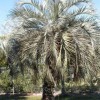Abstract
The pindo or jelly palm is a small, single-stemmed, feather-leaved palm widely grown in warmer parts of the US due to its unusual cold tolerance. It is considered hardy down to about 10°F (USDA zone 8A). The palm is slow-growing, eventually reaching 15 to 20 feet, making it suitable for planting under power lines. This revised 2-page fact sheet was written by Timothy K. Broschat and published by the UF Department of Environmental Horticulture, April 2015.
References
Broschat, T.K. 1998. "Endocarp Removal Enhances Butia capitata Seed Germination." HortTechnology 8:589-587. https://doi.org/10.21273/HORTTECH.8.4.586
Elliott, M. L., T. K. Broschat, J. Y. Uchida, and G. W. Simone. 2004. Compendium of Ornamental Palm Diseases and Disorders. St. Paul, MN: American Phytopathological Society Press.
Meerow, A. W. 2006. Betrock's Landscape Palms. Hollywood, FL: Betrock Information Systems.
Noblick, L. R. 2011. "The Validation of the Name Butia odorata." Palms 55:48-49.
Elliott, M. L., T. K. Broschat, J. Y. Uchida, and G. W. Simone. 2004. Compendium of Ornamental Palm Diseases and Disorders. St. Paul, MN: American Phytopathological Society Press.
Meerow, A. W. 2006. Betrock's Landscape Palms. Hollywood, FL: Betrock Information Systems.
Noblick, L. R. 2011. "The Validation of the Name Butia odorata." Palms 55:48-49.

